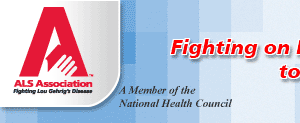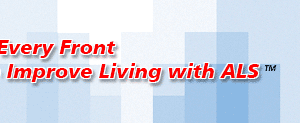

 |
 |
|
May 23, 2007 Researcher Honored, Shares Progress at Advocacy Day Research Session; National ALS Registry Projects Underway in Three States
Stem cell advances for drug discovery and progress toward establishing a national registry of ALS patients were highlights at the National ALS Advocacy Day and Public Policy Conference in Washington, D.C., when The ALS Association hosted a special plenary session which also featured presentations by scientists at the National Institutes of Health who are collaborating with The Association to uncover genetic and environmental factors contributing to the disease. The session opened honoring Tom Maniatis, Ph.D., of Harvard University. Maniatis received the Mulder Award for his years of service on scientific advisory boards for The ALS Association. An expert on gene cloning, Maniatis began his service with The Association following his sister’s diagnosis with the disease and has now steered his own lab into stem cell research aimed at ALS. Already his first project in this area funded by The Association has borne fruit with publication last month in a top tier journal of his findings with stem cells as potential drug discovery tools (Click here for more details).
Maniatis spoke about his approach to using stem cells as a model for ALS. The study of autopsy material donated by ALS patients only gives information at end stage and is not able to reveal what triggers the demise of motor neurons in the disease. Maniatis and others seek to develop a cell that can grow in the lab and will mimic not only the motor neuron death that occurs in ALS but also reproduce the various developmental stages of this cell from birth to death to see what may go wrong. So far his team has showed that embryonic stem cells, derived from a mouse with a mutated protein linked to some inherited cases of ALS, can differentiate in the lab into motor neurons. These cells die faster than healthy motor neurons and have key characteristics of ailing motor neurons: they have abnormal clumps of protein. As is the case with rodents modeling the human disease, the motor neurons derived from stem cells die even faster when they are surrounded by sick neighboring cells called glia. Identifying the toxic factors produced by glia is now the object of intense investigation. Despite the technical and political hurdles to obtain and cultivate human embryonic stem cells, the Maniatis group and others are developing methods to extract, cultivate and prompt human embryonic stem cells to become motor neurons. They intend to use nuclear transfer technology to introduce the genetic material of ALS patients into embryonic stem cells. The hope is that the stem cells will develop in lab dishes to reflect exactly what happens during the disease process in an ALS patient. The strategy should provide a powerful tool, not only to understand more about the disease, but also to help screen for candidate drugs. Story Landis, Ph.D., director of the National Institute of Neurological Disorders and Stroke (NINDS), described how the close partnership between NINDS and organizations such as The ALS Association has resulted in a better understanding of the mechanisms underlying ALS as well as new efforts toward translational research, bringing new advances directly into clinical testing. Co-funded projects between NINDS and The ALS Association have identified new genes involved in inherited ALS as well as the generation of animal models which are useful not only to mimic familial and sporadic human ALS but also to provide a way to screen drugs. Although many exciting discoveries have been made in laboratories, Landis cited the gap that must be bridged in order for a potential drug to access the expensive clinical trial process. The ALS Association is spanning this gap with its initiative, Translational Research Advancing Therapy for ALS (TREAT ALS). Together with The Association, NINDS has a translational program which has funded Phase III testing underway of candidate therapies IGF-1 (myotrophin), minocycline, high dose CoQ10 and ceftriaxone. Ceftriaxone is a good example of how NINDS and The ALS Association were instrumental in bringing a drug identified in a screen of 1040 FDA approved compounds into a clinical trial. Landis noted that economic benefits of such translational programs for ALS are calculated to greatly exceed the costs. Joint projects have also produced the promise of stem cell research and the possibility of a gene therapy. The partnership has also been instrumental for the creation of a repository that contains, to date, samples from 2000 patients and 2000 controls providing an infinite supply of DNA material accessible to all researchers. This repository has been a key to efforts to find new genes presented by Bryan Traynor, M.D., of the National Institutes of Health. Traynor spoke about the efforts to identify genes associated with the sporadic form of ALS (sALS), which constitute 95% of the ALS population. The role of either environmental or genetic factors or both as the underlying cause of sALS is still a matter of debate. The search for genetic predisposition has been hampered by technical difficulties to identify small gene variations. New tools now allow researchers to analyze the entire set of genes (genome) of large groups of people to identify small differences that could be involved in sALS. So-called single nucleotide polymorphisms (SNPs) can indicate where in the genome differences might reside that might be linked to disease. With samples from the NINDS repository, Traynor and his group are analyzing and comparing the genomes of 276 Americans with sALS to 275 Americans with no history of neurological disorders. The technology, developed by Illumina Inc., based in San Diego, has identified a number of small variations in genes involved in maintaining the cell structure
Because existing ALS databases are incomplete and do not represent the entire U.S. population, there is a significant need to created a single nationwide registry. In 2005 and 2006, The ALS Association worked with Congress to direct nearly $2 million to ATSDR/CDC to begin to evaluate the science that is needed to create a registry. In 2006, ATSDR organized a workshop that set a strategy to combine the different databases and unify the procedure to collect data. ATSDR is conducting three pilot studies in South Carolina, Georgia and Minnesota. These studies are developing and testing strategies to efficiently identify ALS patients in a well defined population and determine how to obtain and store data from existing registries. Data are being analyzed in the three states and should provide guidance for the building of a national ALS registry. During the Public Policy Conference, Senator Harry Reid (D-NV) and Representatives Eliot Engel (D-NY) and Lee Terry (R-NE) reintroduced the ALS Registry Act in Congress, legislation that would authorize CDC to establish a single, national ALS patient registry. The ALS Registry Act (H.R. 2295/S. 1382) authorizes $25 million for the registry in fiscal year 2008 and such sums as necessary for fiscal years 2009 through 2012. Reid said, “A national registry will help arm our nation's researchers and clinicians with the tools and information they need to make progress in the fight against ALS. The data made available by a registry will potentially allow scientists to identify causes of the disease and maybe even lead to the discovery of new treatment, a cure for ALS, or even a way to prevent the disease in the first place.” For further details about the registry effort, click here. To help pass this important legislation, visit the Advocacy Action Center of The ALS Association web site at www.alsa.org/policy. Letters you can send directly to your Members of Congress are available on the site. |
|
| |||
The ALS Association �2004 The ALS Association. All rights reserved. Contact the Webmaster |